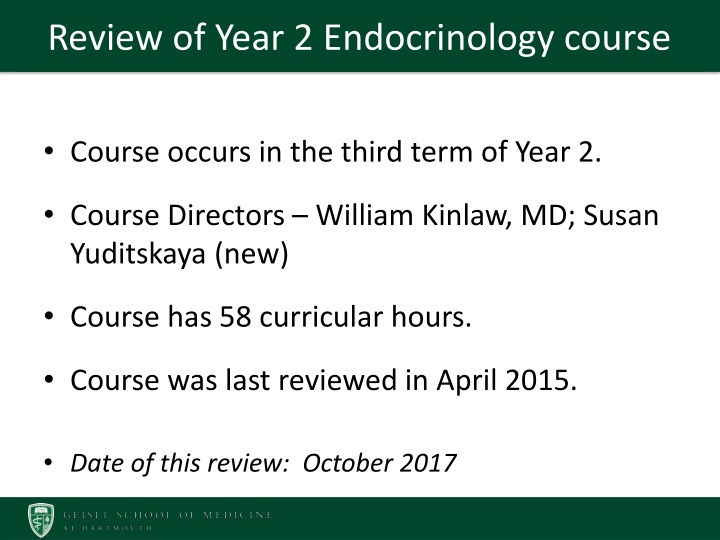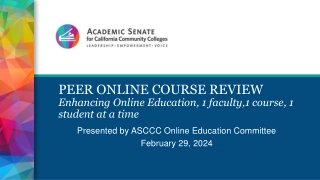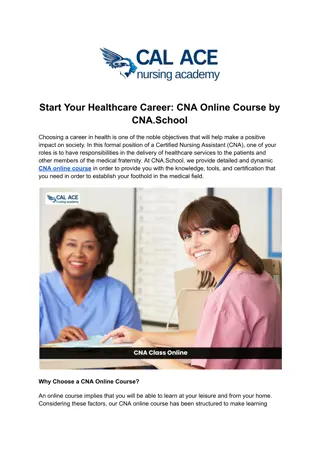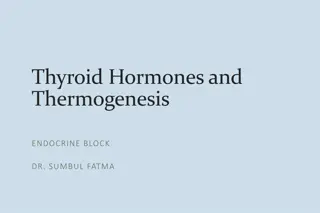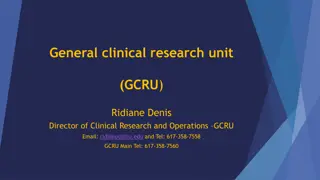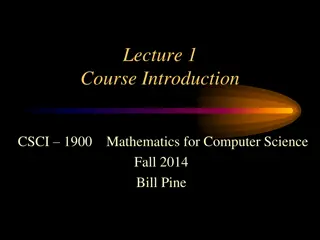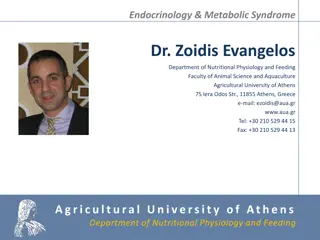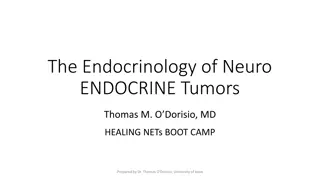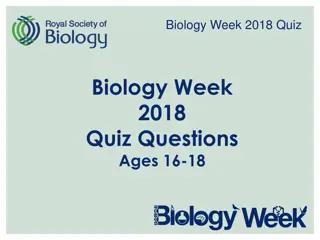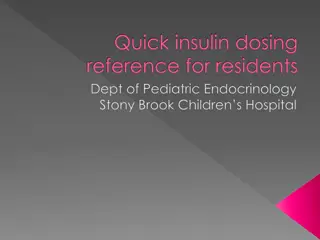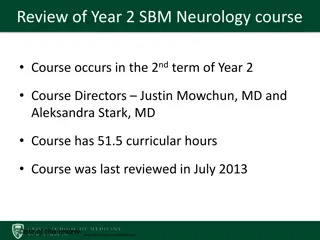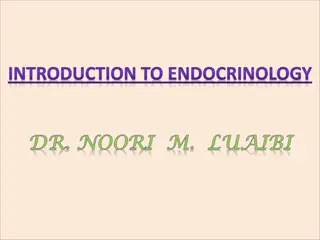Review of Year 2 Endocrinology course
This review covers the Year 2 Endocrinology course, detailing course directors, objectives, action plan, and course content. The course aims to provide a comprehensive understanding of endocrine organs, hormonal imbalances, diagnostic testing, management of endocrine diseases, and more. It also emphasizes problem-solving skills, communication, team participation, and self-directed learning.
Download Presentation

Please find below an Image/Link to download the presentation.
The content on the website is provided AS IS for your information and personal use only. It may not be sold, licensed, or shared on other websites without obtaining consent from the author.If you encounter any issues during the download, it is possible that the publisher has removed the file from their server.
You are allowed to download the files provided on this website for personal or commercial use, subject to the condition that they are used lawfully. All files are the property of their respective owners.
The content on the website is provided AS IS for your information and personal use only. It may not be sold, licensed, or shared on other websites without obtaining consent from the author.
E N D
Presentation Transcript
Review of Year 2 Endocrinology course Course occurs in the third term of Year 2. Course Directors William Kinlaw, MD; Susan Yuditskaya (new) Course has 58 curricular hours. Course was last reviewed in April 2015. Date of this review: October 2017
Action Plan from Prior Review Issue Proposed Solution Some course sessions do not provide session objectives. Ensure handouts and PowerPoints are updated and include session objectives (done) Some cases and handouts are out of date or use old terminology. Revise some outdated terminology (done) Small groups don t provide associated answer keys. Compile take home messages from small groups. Obesity material is not well coordinated with other courses. Participate in MEC VIG for obesity, focusing primarily on endocrine causes and insulin resistance. (done) The scope of the final exam does not ensure proportional representation of the material in the course. Improve the final examination (especially the MCQs). (work in progress)
Course Objectives 1 Review and describe the structure and function of endocrine organs and the general principles of feedback control and homeostasis. 2 Define terms common to the discussion of patients with disorders of the endocrine system (especially diabetes mellitus, and abnormalities of pituitary, thyroid, adrenal and parathyroid glands) and review basic principles. 3 Correlate symptoms and signs with specific hormonal imbalances and receptor dysfunctions (including insulin, growth hormone, thyroid hormones, parathyroid hormones, and adrenal hormones) . 4 Explain the approach to evaluating the cause of specific hormonal excesses or deficiency states. 5 Explain the complications that can arise from various endocrine abnormalities. 6 Describe the epidemiology, risk factors and associations for developing specific endocrine disorders. 7 Discuss the role, utility and significance of diagnostic testing (e.g., blood and imaging) in patients with endocrine disorders. 8 Explain the basis for pharmacological and non-pharmacological interventions in the management of common endocrine diseases. 9 Describe the pathophysiology, and major pathologic features as well as the epidemiology of various pathological processes including neoplasms, inflammation, autoimmunity, and vasculopathy/angiopathy. 10 Explain the levels of evidence in determining effective and cost-effective care and the limitations of each. 11 Utilize the results of outcome studies to evaluate the effectiveness of patient care. 12 Describe how operations and processes that occur within a complex healthcare system have an impact on cost and quality of effective and timely care of the patient with endocrine disorders. 13 Practice and demonstrate systematic problem-solving skills with regard to patients with endocrine disease.
Course Objectives - Continued 14 Communicate with fellow students and faculty about patients with endocrine disease. 15 Demonstrate team skills by participating effectively in team exercises. 16 Take responsibility for his- or her-own medical education. 17 Search efficiently for and obtain recent, high quality, relevant medical information and scientific literature to solve problems. 18 Read critically, evaluate, and assess medical information and scientific literature about important endocrine topics and questions. 19 Explain the nutritional aspects of fad diets 20 Demonstrate the methods for teaching dietary principles and demonstrate how to take a dietary history 21 Explain common dietary programs for diabetes 22 Demonstrate evaluation of food labels, especially carbs and fat 23 List important micronutrients and likely deficiencies of micronutrients 24 Explain dietary therapy for lipid lowering therapy and diabetes nutrition 25 Meet professional responsibilities fully, including being punctual, present, and engaged in meetings and other activities, and being reliable in commitments to tasks.
Mapping of Course Objectives to Geisel Competencies Course directors will review current mapping (to new Geisel competencies) and forward updates to Brian Reid
Course Objectives Comments Several typos in Ilios (corrected in red) There are a fairly large number of course objectives, which may increase further when Health and Values and Nutrition content is reviewed. Some of the course objectives would be more appropriate as session objectives Some of the course objectives can be consolidated into a single objective (or at least smaller number of objectives) Some sessions have detailed objectives; others (such as pathology) have a small number (sometimes only one or two) of extremely broad objectives.
Format of Course & Session Objectives Course objectives are provided in the syllabus Course objectives are written in the correct format Session objectives are provided in the course materials Session objectives are not consistently written in the correct format [many objectives are still phrased as Understand . or Know or Review ]
Issues of Redundancy Are there major issues of redundancy with other courses? No significant issues identified
Health and Values Goals Ethics Identify key concepts in health care ethics and demonstrate an ability to recognize ethical issues arising in patient care and population health and to think critically and systematically in applying an ethical analysis Cultural Awareness Demonstrate an understanding and skill in managing patient care of people of diverse cultures, social, economic standing and belief systems Health Equity Identify the root causes and approaches for addressing health disparities locally and globally Resilience Demonstrate knowledge of skills and practices to prevent and address stress and maintain resilience in caring for patients and oneself Compassion and Empathy Demonstrate abilities to understand each patient s experience of illness, adapt scientifically appropriate care to conform to that patient s needs, and communicate in terms that each patient can understand There also are synergies to health law, communication skills, professionalism (as LCME requires).
Health and Values Content What Health and Values Program material Several of the H&Vs themes included: health equity (cost effective care and impact of health care system on cost/quality), health care ethics (transgender care), cultural awareness (personal/organizational bias, etc.), and professionalism issues Are the Health and Values topics noted in the course and session objectives? A few course objectives relate to health care equity (#10, #12), professionalism (#25), however, not ethics Several transgender sessions objectives (#9 and #27) relate to H&Vs, cultural humility, communication skills, appropriate use of terminology, recognizing personal/institutional bias, also professionalism
Health and Values Content What do the student evaluations indicate regarding Health and Values teaching? Would be great to integrate more ethical issues in the course. For example, the use of dexamethasone in pregnancy is an ethical hot topic...endocrinology has a bunch of good ethical issues-- we should discuss some of them! The transgender portion of the course was excellent and I think touched on all H&Vs I felt like this course contained a bit more than others given the sensitivity of gender identity The transgender panel should be part of the endocrine curriculum.
Recommendations for Health and Values Add course objectives related transgender medicine including the inherent ethical issues Delete course objectives related to health equity if not addressed in sessions (not sure where currently presented/discussed, maybe in session #10, Tally society costs of diabetes Add ethical issues content to the application of growth hormones session (session #12) Course directors should meet with Dr. Nelson to discuss above recommendations, including adding H&Vs to PBLs
Nutrition Objectives Nutrition in Medical Science N-NMS 1. Describe core nutrition science concepts, such as nutritional biochemistry and metabolism, digestion, endocrinology, and adverse effects of malnutrition on human health. N-NMS.1 2. Explain the links between nutrition science and other sciences, including those of the environment, exercise, toxicology, and pharmacology. N-NMS.2 3. Apply core nutrition science knowledge to understand and manage human health and disease through the lifespan. N-NMS.3 Nutrition in Clinical Care N-NCC 1. Perform a nutrition assessment and accurately measure anthropometrics. N-NCC.1 2. Perform a complete nutritional exam to assess for presence of malnutrition. N-NCC.2 3. Interpret, develop, and implement a nutrition plan for treatment, including nutritional additions or restrictions, culinary skill development, artificial nutrition support, and supplementation. N-NCC.3 Nutrition in Population Health N-NPH 1. Explain the impact of nutrition on individual and population health and disease. N-NPH.1 2. Assess the impact of social, environmental, behavioral, economic, cultural, and personal factors on the nutritional health of individuals, and the incidence and burden of disease in populations. N-NPH.2 3. Explain and exemplify the physician s role for promoting nutrition in public health. N-NPH.3
Communication Skills in Nutrition Practice N-NCS 1. Demonstrate empathy for individuals concerns, and be respectful of others perspectives and personal, cultural, and religious dietary restrictions and beliefs, and communicate nutrition advice respectfully and without judgment. N-NCS.1 2. Promote positive behavioral change through nutrition-specific motivational interviewing and cognitive behavioral therapy. N-NCS.2 3. Translate nutrition science concepts in to useful information to educate patients, families, peers, and others.N-NCS.3 Personal, Professional, and Leadership Development in Nutrition Practice N-PPLDNP 1. Engage in lifelong learning to improve one s performance in the application of nutrition science. N- PPLDNP.1 2. Apply nutrition science and culinary competency to enhance resiliency and physician self-care.N- PPLDNP.2 3. Advocate for environments that promote healthy nutritional lifestyles in the community, while removing any existing barriers. N-PPLDNP.3 Evaluation and Improvement in Nutrition Practice N-EINP 1. Identify and utilize healthcare and community resources to provide nutrition care and improve patient outcomes and patient satisfaction. N-EINP.1 2. Identify credible, evidence-based sources of nutrition information and apply knowledge gained from the literature to clinical care, teaching, research, and population health. N-EINP.2 Collaboration and Teamwork in Nutrition Practice N-CTNP 1. Recognize and capitalize on different roles and strengths of team members, including the clinical dietitian, to develop and address shared goals, and foster a working relationship with all team members built on mutual respect and trust. N-CTNP.1 2. Demonstrate the ability to share and allocate responsibilities among team members. N-CTNP.2
Nutrition Content What Nutrition Program material is presented in the course? Fad diets, diet therapy for treatment of diabetes and hyperlipidemia, nutrition label reading, micronutrient deficiencies, methodology for taking diet histories Are the Nutrition topics noted in the course and session objectives? Course Objectives: #19: Explain the nutritional aspects of fad diets. Mapping: N-NMS.3, N-NCS.3, N-EINP.2 #20: Demonstrate the methods for teaching dietary principles and demonstrate how to take a dietary history. Mapping: N-NCC.3, N-NCS.1, N-NCS.2, N-NCS.3, N-CTNP.1 # 21 Explain common dietary programs for diabetes. Mapping: N-NCC.3, N-NMS.3, N-NPH.1, N-NCS.3, N- EINP.2 # 22: Demonstrate evaluation of food labels, especially carbs and fat. Mapping: N-NMS.3, N-NCS.3, N- EINP.1, N-EINP.2 # 23: List important micronutrients and likely deficiencies of micronutrients. Mapping: N-NMS.1, N-NMS.3, N-NCC.1, N-NCC.2, N-NCC.3, #24: Explain dietary therapy for lipid lowering therapy and diabetes nutrition. Mapping: N-NCC.3, N- NMS.3, N-CTNP.1, N-EINP.2, N-EINP.1, N-NCS.3, N-NPH.1 Session Objectives: Session 7, objective 8 Session 8, Objective 6 Session 15, objectives 2 and 5 Session 37, objectives 1 - 13
Nutrition Content Student comments: What do the student evaluations indicate regarding Nutrition teaching? N/A
Recommendations for Nutrition Integration Recommendations for Nutrition Education: 1. Develop specific evaluation questions to allow for evaluation of nutrition content 2. Additional Potential Sessions for Nutrition content: 30, 31, 34 3. Utilize available resources (Nutrition in Medical Education Program) for development and dissemination of course nutrition content as needed
Summary regarding Objectives Need to correct misspellings in Ilios course objectives Course objectives should be modified: Some can be consolidated into a smaller number of objectives Some should be expanded upon (e.g. instead of Explain the complications that can arise from various endocrine abnormalities, add a phrase that lists the major endocrine abnormalities that would be addressed in this objective (e.g. change to Explain the complications that can arise from various endocrine abnormalities, such as diabetes, acromegaly, etc., etc.)
Summary regarding Objectives (contd) Meet with Health and Values and Nutrition Faculty to review the relevant content and associated objectives Session objectives need significant modification: Change wording to measurable verbs (eliminate understand , know , review etc.) Provide session objectives that are as detailed as possible these are lacking for several sessions, particularly the pathology sessions.
Course Learning Opportunities Hours % Lecture Conference 21.5 21 37 36 Patient contact hours 5 9 Laboratory Interactive large group Final exam 4 7 4 7 2.5 4 15-16 Hours: 23.5 Lecture hrs; 2.5 ILG hrs; Patient Contact 4 hrs; Conference 21 hrs; Lab 4 hrs; Exam 4 hrs; Total 59 hrs (MEC requested that 1 hour be eliminated to offset addition of Y2 P&P hour was eliminated in AY16-17)
Summary regarding Pedagogy Courses offers a variety of formats Meets goal of < 40% lecture
Assessment Students must pass both a Final Exam and the Engagement portion of the course. Receive certification from your small group leader that you have attended and participated in all conference sessions, or completed appropriate makeup work as assigned by Dr. Kinlaw Score at least 11 points for the following activities: 9 small group sessions (attendance worth 1 point for each session) Attend the Diabetic Complications session (1 point) Attend the Thyroid Patient Presentation (1 point) Attend the Pediatric Patient Presentation (1 point)
Assessment for Course Objectives Assessments include: Final examination Participation and engagement in 18 hours of small group conference
Measures of Quality Graduation Questionnaire Data from AAMC Graduation Questionnaire
Measures of Quality Step I 2014* 2015* 2016* Means 14-16 SYSTEMS-BASED TOPICS Behavioral sciences 0.15 -0.1 -0.43 -0.13 Behavioral Health and Nervous system 0.06 -0.10 -0.18 -0.07 Biostatistics, Epidemiology, Pop Health 0.01 0.22 N/A 0.12 (14-15) Cardiovascular system 0.02 0.16 -0.1 0.03 Endocrine system 0.39 0.24 0.09 0.24 Gastrointestinal system 0.54 0.2 0.06 0.27 Hematopoietic/lymph systems 0.09 0.10 -0.15 0.01 Immune system 0.16 -0.07 -0.02 0.02 Musculoskeletal, skin, CT systems -0.02 0.22 0.15 0.12 Nutrition 0.22 -0.08 -0.15 -0.003 Renal/urinary system 0.23 0.02 -0.27 -0.007 Reproductive system 0.39 -0.03 -0.04 0.11 Respiratory system 0.18 0.27 -0.22 0.08 *values reported for core disciplines are SD above the US/Can mean for Geisel mean scores
Measures of Quality AAMC GQ Measures of Quality Course Evaluation Overall Quality AY 15-16 Overall Quality AY 16-17 Year 2 courses 3.69 3.90 Cardiology 3.23 3.46 CT & Bone 3.89 3.84 Dermatology 3.88 3.67 Endocrine 3.85 3.97 FEK 4.31 4.45 GI 4.26 4.44 Hematology 4.02 4.24 Infectious diseases 3.74 4.03 Introduction to Pharmacology 3.35 3.43 Introduction to SBM Themes 3.06 3.40 Nervous system 3.60 4.02 On Doctoring 4.16 3.63 Psychiatry 3.05 2.96 Reproduction 4.08 4.27 Respiration scale [1=poor; 2=fair; 3=good; 4=very good; 5=excellent]
Measures of Quality Course Evaluation scale [1=poor; 2=fair; 3=good; 4=very good; 5=excellent] SBM 207 AY 14-15 (79.3%)* SBM 207 AY 15-16 (92.3%)* SBM 207 AY 16-17 (97.9%)* Overall satisfaction of course 4.09 3.88 3.67 Clarity of learning objectives 3.93 3.95 4.00 Organization of the course 3.91 3.83 3.71 How well the course introduced me to this discipline 4.26 4.10 3.89 Congruence of assessment questions to material emphasized in course 3.08 3.50 3.44 *student participation rate on course evaluation
Measures of Quality Student Comments Strengths: Strong small group leaders with specific appreciation for writing on the board, responsiveness to e-mails with questions, approachability, balance of clinical and scientific knowledge Enthusiasm of Drs. Kinlaw and Memoli: His evident zeal for the subject matter was infectious I love lectures with Dr. Memoli...it s very evident how much he enjoys pathology and teaching students Diabetes lecture from Dr. Chaidarun: did an excellent job introducing us to Diabetes and other subjects.
Measures of Quality Student Comments Strengths: For pathology with Dr. Memoli, appreciation of working through problems in pairs first, then proceeding with large group learning for more complex concepts Great patient presentations and lectures from Drs. Casella and St. Germain: Dr. Casella: one of the best of the year. Great balance between narrative and engaging the class with content and clinical interviewing skills Dr. St. Germain: truly did a wonderful job presenting often difficult concepts in a clear and approachable manner ; Cushing s Disease best patient presentation we have had yet.
Measures of Quality Student Comments Suggestions for Improvement: Small groups could benefit from answer keys/notes covering take away points Lectures should be available on ECHO or advance notice should be given if they will not be Lecture on transgender issues could include more medicine, such as hormone replacement Hypoglycemia lecture could benefit from more organization and clarity Final exam could encompass more topics because it was diabetes heavy and neglected other topics The MCQs comprising the final examination do not conform with the style used on the boards. Pathology could benefit from being moved to Chilcott for a more interactive session and adopting SBM FEK approach where students see the slide, have a few minutes to think, then pathologist walks them through the slide
Measures of Quality Student Comments Suggestions for improvements: Endocrine hypertension lecture could benefit from more concise slides and sticking to allocated time Improve online platform for pathology to make it more Mac- friendly Lipids lecture & slides : lipids lecture could use a couple of review slides at the end for take away especially with regards to mechanisms. slides difficult to reference as study tool graphics and charts could have been more concise.
Summary regarding Measures of Quality Students do well on endocrine portion of Step 1 Overall, course rated in the good-very good range; rating was slightly below mean for all Year 2 courses Many favorable comments from students, particularly about small group conferences, though many students remain concerned about variations in small group and the lack of an answer key Concern might be allayed, at least in part, by providing detailed session objectives
Action Plan Item #1. Update course objectives. Plan: The course objectives and method of assessment (small group (SG) or exam (EX)) have been updated revised objectives are at the end of this PowerPoint. Item #2: Many of session objectives need to revised Plan: Revise session objectives (done) Item #3. Health and Values Content. Plan: Course directors will meet with Bill Nelson to review H&V objectives and content. Item #4. Nutrition content. Plan: Course directors will meet with Rima Al-Nimr to review nutrition objectives and content.
Action Plan Item #5. The scope of the final exam does not ensure proportional representation of the material in the course. Plan: Revise the examination to achieve better overall congruence with the course. Item #6. The MCQs comprising the final examination do not conform with the style used on the boards. Plan: Edit the MCQs Item #7: Student comments about individual sessions Course directors will review the sessions in question and consider any changes that need to be made.
Revised Course Objectives 1 Review and describe the structure and function of endocrine organs and the general principles of feedback control and homeostasis. (SG, EX) 2 Define terms common to the discussion of patients with disorders of the endocrine system (especially diabetes mellitus, and abnormalities of pituitary, thyroid, adrenal and parathyroid glands) and review basic principles. (SG) 3 Correlate symptoms and signs with specific hormonal imbalances and receptor dysfunctions (including insulin, growth hormone, thyroid hormones, parathyroid hormones, and adrenal hormones) . (SG, EX) 4 Explain the approach to evaluating the cause of specific hormonal excesses of deficiency states in patients of all ages. (SG) Explain the complications that can arise from various endocrine abnormalities, including diabetes, pituitary, thyroid, and adrenal disorders, and describe their treatment in patients of all ages. (SG, EX) 5 6 Describe the epidemiology, risk factors and associations, including sex, genetics, and ethnicity, for developing specific endocrine disorders in patients of all ages. (SG, EX) 7 Discuss the role, utility and significance of diagnostic testing (e.g., blood and imaging) in patients with endocrine disorders. (SG, EX) 8 Explain the basis for pharmacological and non-pharmacological interventions in the management of common endocrine diseases. (SG, EX) 9 Describe the pathophysiology, and major pathologic features as well as the epidemiology of various pathological processes including neoplasms, inflammation, autoimmunity, and vasculopathy/angiopathy. (SG, EX) 10 Describe how operations and processes that occur within a complex healthcare system have an impact on cost and quality of effective and timely care of the patient with endocrine disorders. (SG) 11 Practice and demonstrate systematic problem-solving skills with regard to patients with endocrine disease. (SG)
Revised Course Objectives - Continued 12 Communicate effectively with fellow students and faculty about patients with endocrine disease, and meet professional responsibilities, including punctuality and meaningful engagement in course sessions. 13 Take responsibility for his- or her-own medical education. (SG) 14 Search efficiently for and obtain recent, high quality, relevant medical information and scientific literature and evaluate it critically to solve problems. (SG) 15 Describe the roles of nutrition and diet in the pathogenesis and management of disorders such as diabetes and hyperlipidemia. (SG)
